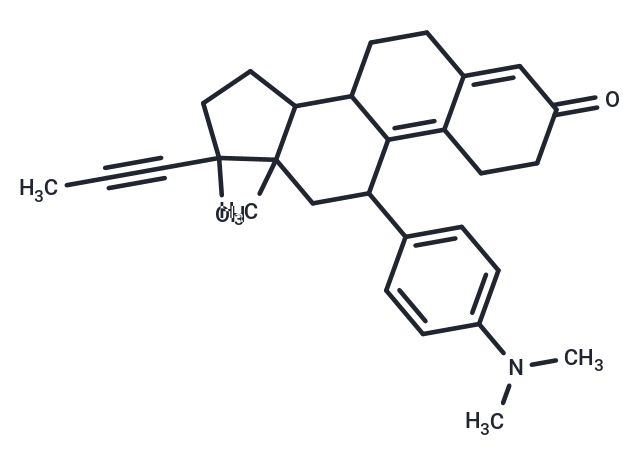Shopping Cart
- Remove All
 Your shopping cart is currently empty
Your shopping cart is currently empty

Mifepristone (C-1073) is a Progestin Antagonist. The mechanism of action of mifepristone is as a Progestational Hormone Receptor Antagonist.

| Pack Size | Price | Availability | Quantity |
|---|---|---|---|
| 50 mg | $33 | In Stock | |
| 100 mg | $48 | In Stock | |
| 500 mg | $84 | In Stock | |
| 1 g | $119 | In Stock | |
| 1 mL x 10 mM (in DMSO) | $50 | In Stock |
| Description | Mifepristone (C-1073) is a Progestin Antagonist. The mechanism of action of mifepristone is as a Progestational Hormone Receptor Antagonist. |
| Targets&IC50 | Progesterone receptor:0.2 nM, HEK293 cells:0.298 nM, MCF7 cells:24.03 μM, SUM149PT cells:15 μM, K562 cells/R7:0.9 μM, HCC1937 cells:> 20 μM, T47D cells:0.045 nM, COS-7 cells:0.6 nM, CHO cells:5 nM, LNCaP cells:11.9 nM (EC50), GR:2.6 nM, CHO cells-K1 cells:0.4 nM, A549 cells:1.6 nM |
| In vitro | Mifepristone, at the highest dose in rats, significantly reduced prostate weight and largely inhibited dihydrotestosterone-induced prostate growth and induced atrophy and cell death. Mifepristone inhibited SK-OV-3 tumor growth in immunosuppressed mice at 0.5 mg and 1 mg per day. |
| In vivo | Mifepristone, at the highest dose in rats, significantly reduced prostate weight and largely inhibited dihydrotestosterone-induced prostate growth and induced atrophy and cell death. Mifepristone inhibited SK-OV-3 tumor growth in immunosuppressed mice at 0.5 mg and 1 mg per day. |
| Kinase Assay | Glucocorticoid receptor (GR) antagonist activity, Progesterone receptor (PR) antagonist activity: T47D alkaline phosphatase assay: T47D human breast cancer cells are plated in 96-well tissue culture plates at 104 cells per well in assay medium [RPMI medium without phenol red containing 5% (v/v) charcoal-treated FBS and 1% (v/v) penicillin–streptomycin]. Two days later, the medium is decanted and Mifepristone or control is added at a final concentration of 0.1% (v/v) dimethylsulfoxide in fresh assay medium. Twenty-four hours later, an alkaline phosphatase assay is performed using a SEAP kit. The medium is decanted and the cells are fixed for 30 minutes at room temperature with 5% (v/v) formalin. The cells are washed once at room temperature with Hanks' buffered saline solution. Equal volumes (0.05 mL) of dilution buffer, assay buffer, and 1:20 substrate/enhancer mixture are then added. After 1-hour incubation in the dark at room temperature, the lysate is transferred to a white 96-well plate and luminescence is read using a LuminoSkan Ascen. A549 reporter assay: A549 human lung carcinoma cells are washed with OPTI-MEM I. The medium is removed and lipid–DNA complex solution (1.5 μg/mL of GRE-luciferase reporter DNA in 8.5 mL OPTI-MEM I plus 6 μL/mL DMRIE-C reagent in 8.5 mL OPTI-MEM I, combined, mixed and incubated at room temperature for 40 minutes) is overlayed onto the cells in a T160 flask. The cells are incubated for 16 hours at 37 °C in a CO2 incubator. The DNA-containing medium is removed and 30 mL of growth medium containing 5% (v/v) charcoal-treated fetal bovine serum is added. After 5-6 hours, the cells are seeded in 96-well plates and incubated overnight at 37 °C. Mifepristone is then added to each well followed by dexamethasone as a corticoid challenge. The cells are incubated for 24 hours. Luciferase assay buffer is added to each well and the cells are incubated for 30 minutes at room temperature.Luciferase activity is measured in a DYNEX Microlite plate on a TopCount. |
| Cell Research | Cell growth is evaluated in various ovarian cancer cell lines that are subjected to dose-response or time course treatments. Media containing each of the doses of fresh steroids is replaced every 24 hours. Control groups of cells are treated with vehicle ethanol at a final concentration of less than 0.05%. Number of viable cells is evaluated by trypsinization and counting in a hemocytometer chamber using trypan blue dye exclusion. Experiments are conducted in media without phenol red and supplemented with charcoal extracted fetal bovine serum, or media containing unextracted serum and having phenol red. Similar results are obtained with both media preparations; therefore, after performing the growth curves, all subsequent experiments are conducted using media with unextracted serum and in the presence of phenol red. When indicated, the proliferation IC50s are calculated using software designed to study drug interaction. (Only for Reference) |
| Alias | RU486, RU 38486, C-1073 |
| Molecular Weight | 429.59 |
| Formula | C29H35NO2 |
| Cas No. | 84371-65-3 |
| Smiles | CC#CC1(O)CCC2C3CCC4=CC(=O)CCC4=C3C(CC12C)C1=CC=C(C=C1)N(C)C |
| Relative Density. | 1.18 g/cm3 |
| Storage | Powder: -20°C for 3 years | In solvent: -80°C for 1 year | Shipping with blue ice/Shipping at ambient temperature. | ||||||||||||||||||||||||||||||||||||||||
| Solubility Information | DMSO: 45 mg/mL (104.75 mM), Sonication is recommended. Ethanol: 21.5 mg/mL (50 mM)), Heating is recommended. | ||||||||||||||||||||||||||||||||||||||||
| In Vivo Formulation | 10% DMSO+40% PEG300+5% Tween 80+45% Saline: 4.3 mg/mL (10.01 mM), Suspension. Please add the solvents sequentially, clarifying the solution as much as possible before adding the next one. Dissolve by heating and/or sonication if necessary. Working solution is recommended to be prepared and used immediately. The formulation provided above is for reference purposes only. In vivo formulations may vary and should be modified based on specific experimental conditions. | ||||||||||||||||||||||||||||||||||||||||
Solution Preparation Table | |||||||||||||||||||||||||||||||||||||||||
Ethanol/DMSO
DMSO
| |||||||||||||||||||||||||||||||||||||||||

Copyright © 2015-2025 TargetMol Chemicals Inc. All Rights Reserved.